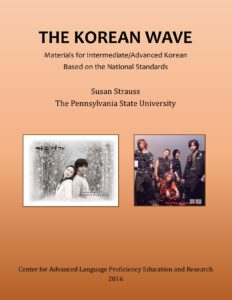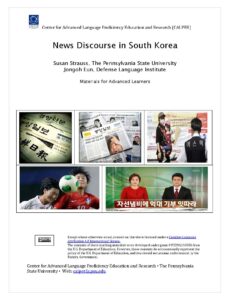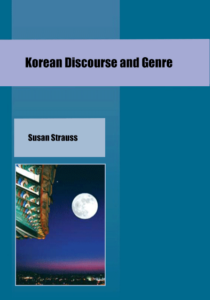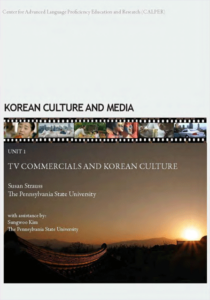Metaphors in Korean
Metaphors in Korean is part of the units developed in the project ‘Metaphoric Competence in the Foreign Language Classroom.”
The unit contains guided activities that help students first study metaphorical associations and explore how associations may differ cross-culturally. The students are introduced to some expressions connected with the respective metaphors and they learn about their meanings. Students will learn to identify, interpret, and produce metaphoric language in their L2.
Background information is available in:
Bobrova, L., & Lantolf, J. P. (2012). Metaphor and Pedagogy (CALPER Working Paper Series, No. 11). The Pennsylvania State University: Center for Advanced Language Proficiency Education and Research. Available as a free download on our site under “Publications“.

Publication Units:
Metaphors in Korean – Animals, Colors, Emotions, Sports
(1) Student Unit
(2) Dictionary
Publication Files:
The Korean Wave
Audiences around the world are now enjoying media products of The Korean Wave, including the wide variety of K-Drama, movies, and K-Pop. K-Dramas are broadcast not only in South Korea, but also in Japan, China, Indonesia, the Philippines, Iran, Kuwait, UAE, all throughout North and South America, and parts of Africa, including Zimbabwe and Ghana. K-Pop music has fan followers from small, rural villages to ultra modern metropolises, literally spanning the globe.
The six units in this newest series focus on The Korean Wave. Units 1, 2, and 3 provide a general history and overview of The Korean Wave as well as rich samples of K-Drama excerpts, like scripts and links to video clips, and
activities to explore the discourse and compare and contrast cultural practices and products. Units 4, 5, and 6 document the history of K-Pop and provide an overview of this music genre, with a specific focus on two modern idol groups, BUZZ and EXO. Here you’ll find a robust sampling of news releases, fandom blogs, and song lyrics, also with links to selected music videos. The materials contain a variety of activities for students to explore and experience K-Pop song lyrics, fans’ reactions to their favorite groups, and bits of information on behind-the-scenes production and management operations.
Like all of the units in our Discourse and Genre series, The Korean Wave units match the goals of the Korean National Standards and are designed for teachers and students to work toward increasing proficiency in the 5Cs, while working with a complex set of discourse-based materials and activities.

Publication Units:
Korean Drama
Winter Sonata
You’re Beautiful
K-Pop
K-Pop BUZZ
K-Pop EXO
Korean News Discourse
Korean News Discourse is a new CALPER project. Instructional materials for high-intermediate and advanced learners of Korean will be developed that focus on typical and critical features of the news genre. The basis for the materials is comprised of a large set of authentic texts, such as traditional newspapers, magazines, TV news broadcasts and online news outlets.
If you are using these materials in your courses, please drop us a line an let us know. Contact Professor Susan Strauss with your feedback.

Publication Units:
Korean News Discourse. Unit 1: Introduction
Korean News Discourse. Unit 2: Headlines
Publication Files:
Korean Discourse and Genre
The units in the series “Korean Discourse and Genre” are designed to complement existing pedagogical materials for Korean. They contain authentic, media-based samples of actual language used in Korea by Koreans for specific interactional purposes: television programs (e.g., talk shows, reality shows, news, weather reports), radio programs, films, internet-based discourse (interviews, reviews, blogs, news items, recipes), and the like. As the title of the series suggests, the focus of the materials is on Discourse and Genre. Discourse relates generally to language and how language is used in these various communicative contexts. Genre refers to the specific ways in which particular features of language combine to create a certain type of discourse, e.g., conversation, expository writing, formal interview, recipes, weather reports, diary entries, and so forth. All units are based on the newly developed National Standards for Korean.
Korean Holidays
The central theme of Units 1 – 4 are major Korean holidays: 설, 보름, 단오, and 추석. The units open with a brief description of each holiday and its importance within Korean culture. Each unit then branches off in directions that relate these events to other issues in Korean daily life: traditional culture, foods, health and well-being, cultural values and practices, family, travel, weather, and so forth. Each unit is designed to both provide a variety of discourse genres, e.g., expository writing, narrative, recipes, e-mail, interview, chat, blog, and so forth, and have students interact within these various genres. The final section of each unit discusses the specific types of discourse genres used as text in the unit, and isolates particular features of each genre for further study.

Publication Units:
Korean Holidays
Unit 1. Lunar New Year
Unit 2. First Full Moon of the Lunar Year
Unit 3. Summer Festival Holiday – (5th day of the 5th month in the lunar calendar)
Unit 4. Mid-autumn Festival
Korean Culture and Media Series
The fundamental goal of this series is to present language and culture as an integral whole—to enhance students’ awareness of language through culture and to deepen students’ understanding of culture through language. Through the materials presented in our Culture and Media Series workbooks, students will be able to acquire and exchange information about Korea and about Korean people. Because we use actual media-based materials designed in Korea for Koreans, students will have the opportunity to observe language and culture in action and to more deeply understand the values and viewpoints that underlie the socio-cultural practices of Korean people.

Publication Units:
Unit 1: TV Commercials and Korean Culture
In Unit 1, we present a collection of television commercials, some of which were broadcast in Korea in June 2006. We present these audio-video snippets as cultural artifacts that reflect elements of Korean culture in multiple ways.
Unit 2: A Comparative Approach to Culture through Television Commercials: The Case of Korean and the U.S.
Unit 2 consists of a number of television commercials that were broadcast in Korea and a number of commercials broadcast in the U.S. In each case, we provide samples of commercials for the same type of product. That is, we have representative ads from each country for 1) rice, 2) beer, 3) automobiles, and 4) credit cards.
Unit 3: “The King and the Clown” (Film Series)
We discuss the 조선 Dynasty; the life of 연산군; the Korean caste system; traditional Korean music, dance, theatre, and acrobatic performances; and Korean theatre and film vis à vis theatre and film in other countries.
Unit 4: “Le Grand Chef” (Film Series)
We explain the background of the film’s origins, i.e., a comic strip, a book, and then a television program. We discuss traditional cooking practices, including the traditional kitchen, utensils, foods, and so forth. We also touch on the “language of food” in Korea and the United States, and examine the emergence of cooking competitions around the world. We also examine the genre of the “movie review” in Korea and the U.S.
Unit 5: “Radio Star” (Film Series)
We discuss pop culture in Korea and the world from the point of view of The Korean Wave. We also examine the concept of the pop star in Korea and elsewhere. This unit also compares the Academy Awards with the Blue Dragon Awards in Korea.